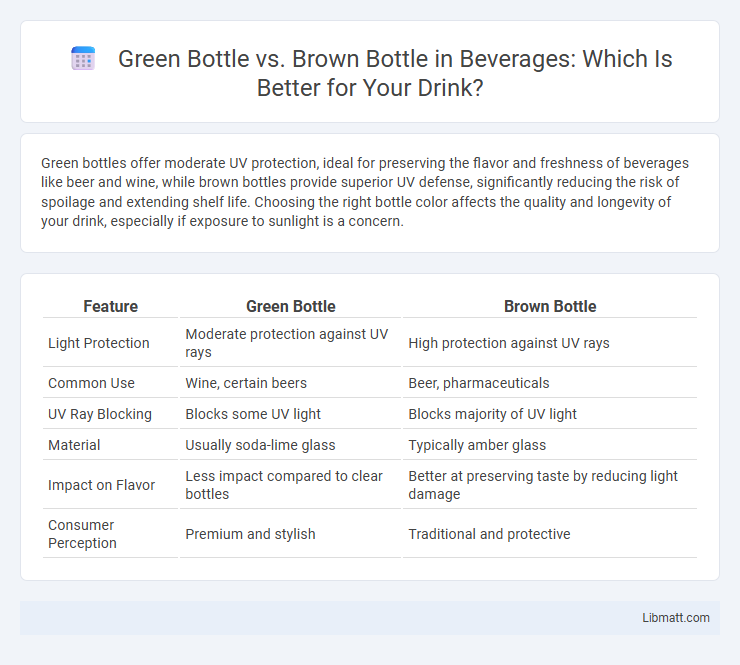Green bottles offer moderate UV protection, ideal for preserving the flavor and freshness of beverages like beer and wine, while brown bottles provide superior UV defense, significantly reducing the risk of spoilage and extending shelf life. Choosing the right bottle color affects the quality and longevity of your drink, especially if exposure to sunlight is a concern.
Table of Comparison
| Feature | Green Bottle | Brown Bottle |
|---|---|---|
| Light Protection | Moderate protection against UV rays | High protection against UV rays |
| Common Use | Wine, certain beers | Beer, pharmaceuticals |
| UV Ray Blocking | Blocks some UV light | Blocks majority of UV light |
| Material | Usually soda-lime glass | Typically amber glass |
| Impact on Flavor | Less impact compared to clear bottles | Better at preserving taste by reducing light damage |
| Consumer Perception | Premium and stylish | Traditional and protective |
Introduction to Green and Brown Bottles
Green and brown bottles serve specific roles in packaging, primarily in preserving the quality of beverages. Brown bottles offer superior protection against harmful UV light, prolonging the freshness of beer and other light-sensitive liquids. Green bottles provide moderate UV protection and are often chosen for their aesthetic appeal in products like wine and specialty beers.
Historical Evolution of Bottle Colors
The historical evolution of bottle colors reveals green and brown glass as primary choices, each developed for specific preservation needs. Brown bottles, often called amber bottles, emerged in the early 20th century for their superior protection against UV light, making them ideal for beer and pharmaceuticals. Green bottles, historically linked with European wines and certain beers, offered moderate light protection while also appealing to consumer preferences for aesthetic and regional identity.
Material Composition Differences
Green bottles are typically made from soda-lime glass infused with iron and chromium oxides, giving them their characteristic green hue, while brown bottles contain higher amounts of iron and sulfur compounds, resulting in a darker amber color. The material composition differences affect their light-filtering properties, with brown bottles offering superior protection against UV rays that can degrade liquids such as beer or pharmaceuticals. Your choice between green and brown bottles should consider how the specific glass composition impacts product preservation and shelf life.
Light Protection: UV Shielding Comparison
Green bottles offer moderate protection against UV light, effectively filtering some harmful rays but allowing more light compared to brown bottles. Brown bottles provide superior UV shielding by absorbing a broader spectrum of light, significantly reducing oxidation and preserving the quality of light-sensitive contents such as beer and pharmaceuticals. The enhanced UV protection of brown bottles helps maintain product freshness and extends shelf life by minimizing photodegradation.
Impact on Beverage Quality and Shelf Life
Green bottles provide moderate protection against light exposure, filtering out some UV rays but allowing more light penetration than brown bottles, potentially affecting the flavor and quality of beverages like beer and wine. Brown bottles offer superior UV protection, significantly reducing light-induced oxidation and preserving taste, aroma, and shelf life by minimizing photodegradation. Beverages stored in brown bottles typically maintain their freshness and quality longer, making them preferable for products sensitive to light exposure.
Environmental Considerations and Recycling
Green bottles and brown bottles both offer environmental benefits through recyclability, but brown bottles generally provide better UV protection, leading to longer shelf life and less product waste. The recycling rates for brown glass tend to be higher due to its widespread use in the beer industry, which supports circular economy practices. Both colors are made from similar materials, but the choice depends on balancing environmental impact, product preservation, and regional recycling infrastructure.
Consumer Perceptions and Brand Identity
Green bottles often evoke associations with freshness and natural qualities, appealing to consumers seeking eco-friendly or organic products, while brown bottles convey traditional craftsmanship and durability, reinforcing brand identity rooted in heritage and quality. The color differentiation impacts shelf presence and consumer trust, with green bottles suggesting innovation and environmental consciousness, whereas brown bottles emphasize authenticity and classic appeal. Brands strategically choose bottle colors to align with target demographics, influencing purchasing decisions and strengthening brand recognition through visual cues.
Popular Uses: Beer, Wine, and Spirits
Brown bottles dominate the beer industry due to their superior UV protection, preserving flavor and freshness by preventing light-induced spoilage, especially for hop-forward beers. Green bottles are commonly used for certain wine varieties, like Riesling and Gruner Veltliner, where tradition and marketing appeal outweigh light protection concerns, though they offer less UV resistance than brown bottles. Spirits such as whiskey and vodka frequently use clear or tinted bottles, with brown bottles occasionally chosen for aesthetic branding, but protection from UV light is less critical due to barrel aging and packaging practices.
Economic Implications for Manufacturers
Green bottles often incur higher production costs due to the need for specific raw materials and coloring agents, impacting manufacturers' profit margins compared to brown bottles. Brown bottles provide better protection against UV light, reducing product spoilage and potentially lowering costs related to quality control and returns. Your choice between green and brown bottles affects supply chain expenses, brand positioning, and overall manufacturing efficiency in the beverage industry.
Future Trends and Innovations in Bottle Design
Green bottles are increasingly integrating eco-friendly materials such as recycled glass and bioplastics, aligning with sustainable packaging trends to reduce carbon footprints. Brown bottles continue to evolve with advanced UV-blocking technologies, enhancing preservation of light-sensitive beverages while minimizing spoilage. Innovations in smart bottle design, including embedded sensors and customizable features, are projected to drive consumer engagement and improve product freshness for both green and brown bottles.
Green bottle vs brown bottle Infographic

 libmatt.com
libmatt.com